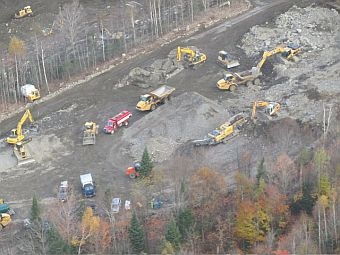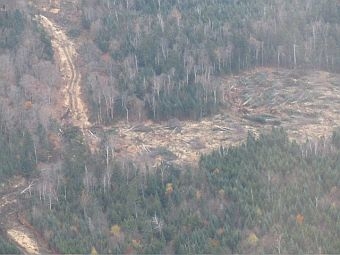Wind Projects Backed By Tax Credits, Subsidies
Thursday, 02/03/11 7:50am
John Dillon - Montpelier, VT

(Last of Three Parts) Most people think of big wind projects as a way to harvest the breezes that blow freely across the earth.
But sophisticated investors look at big wind quite differently. That's because besides generating electricity, the large-scale projects also involve sophisticated financial instruments that harvest a variety of tax benefits.
In the last of our series on big wind, VPR's John Dillon has this look at how the projects are financed.
(Dillon) This is a story about finance, tax credits and energy subsidies. So point number one. Almost all energy production is subsidized.
Nuclear power, for example, is backed up by the federal government. If a reactor melts down, the feds are ready to underwrite the monumental insurance costs.
Some oil company subsidies date to the 1920s.
Tax incentives and subsidies for renewable resources are much more recent. Now, says energy developer John Warshow, the government assistance is seen as an essential part of the complex financing for these projects.
(Warshow) "Developing a project is like juggling with being blindfolded and having five balls you got to keep track of. You've got your debt financing, your equity financing, your power sales."
(Dillon) In his younger, scruffier days, Warshow fought nuclear power. He later turned his activism into action. His office wall in Montpelier features pictures of some of the renewable enterprises he's helped launch, including hydro projects in Vermont and wind in New York state.
Although wind is free, the projects are expensive to start with because of the cost of the turbines, the land and the permitting requirements.
http://www.vpr.net/news_detail/89937/
Which leads us to point number two. Because of that expense, private financiers are needed along with the government support. Investors use the tax credits to offset their income.
(Warshow) "Generally there are investors, either individual or corporate investors, who put cash into the project."
(Dillon) To raise all the money they need, the developers' financing resembles a multi-layered birthday cake. The tax financing piece is one layer; power sale contracts are another. Loans are yet another piece of the overall package. Warshow outlines the three main incentives used by wind investors. There are direct payments allowed under the recent stimulus bill, tax credits for energy production, and tax credits for investment.
(Warshow) "You can't do all three, you have to pick which one is most appropriate for you."
(Dillon) The production tax credit basically cuts the cost of electricity that's sold. That helps the power producer. The investment tax credit - as the name suggests - is more geared for the investor. Warshow does the math on a hypothetical project that costs $40 million dollars.
(Warshow) "Maybe half of that might be debt so that would be $20 million. And the equity investors would be entitled to 30 percent of that $40 million if they took the tax credit, so that would be $12 million they would get back pretty much instantly on their investment."
(Downes) "These are tax shelters for the investors. Pure and simple. They are nothing more than that."
(Dillon) William Downes is a financial analyst in Maine who has looked closely at wind financing. He says the tax credits have a market of their own. They can be bundled and re-sold to companies, hedge funds or individuals.
(Downes) "Whatever investor they bring in is obviously a big institution with a lot of taxable income they want to shelter."
(Dillon) Downes says companies and investors also take advantage of accounting rules that allow for accelerated depreciation of turbines and other equipment. He says the investments can be lucrative.
(Downes) "So, in effect, the investor will get an after-tax return of 7-8 percent, maybe higher.'
(Dillon) Just as nuclear power wouldn't be viable without the federal insurance guarantee, many wind projects wouldn't be built without the various tax breaks.
Green Mountain Power has made this point before the state Public Service Board. The company says it has to have the Lowell Mountain project up and running before the end of December 2012, when the production tax credits expire.
(Dostis) "Without those we would probably shelve the project for a while until either the tax credits were available or economics changed."
(Dillon) Robert Dostis is a GMP vice president. He says that because GMP's rates and profits are set by regulators, customers reap the benefits of the tax credits.
(Dostis) "The production tax credit that expires in 2012 is important because it keeps the cost of the project down. And that savings go directly to what the customer pays."

(Dillon) But there's still a third point to be made. Even with the tax advantages, wind projects are not guaranteed money-makers.
First Wind in Boston is an example. It's developing a project in Sheffield in the Northeast Kingdom.
Late last year, the company was poised to sell stock to the public, so its financing is detailed in a filing with the Securities and Exchange Commission. The documents show the company has high debt and negative cash flow. Spokesman John Lamontagne says tax credits help the company compete with other energy sources.
(Lamontagne) "The tax credits allow renewable energy projects to be operating on a level playing field with fossil fuels. Fossil fuels also receive significant levels of government assistance."
(Dillon) But even with the help of the tax credits, First Wind also has about $528 million in long-term debt. The company told the SEC that if it can't meet the loan terms it could be forced to declare bankruptcy.
It turned out investors weren't willing to pay what First Wind wanted of them. So it canceled its stock offering. And added to its existing debt. To build the Sheffield project, it borrowed another $76 million.
For VPR News, I'm John Dillon in Montpelier.
**************************************
Fair Use Notice: This website may reproduce or have links to copyrighted material the use of which has not been expressly authorized by the copyright owner. We make such material available, without profit, as part of our efforts to advance understanding of environmental, economic, scientific, and related issues. It is our understanding that this constitutes a "fair use" of any such copyrighted material as provided by law. If you wish to use copyrighted material from this site for purposes that go beyond "fair use," you must obtain permission from the copyright owner
Views: 81
Comment
© 2025 Created by Webmaster.
Powered by
![]()
You need to be a member of Citizens' Task Force on Wind Power - Maine to add comments!
Join Citizens' Task Force on Wind Power - Maine